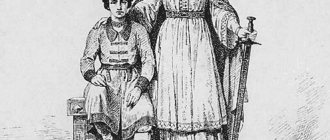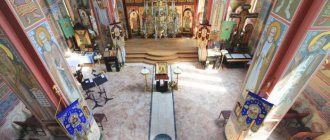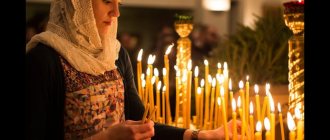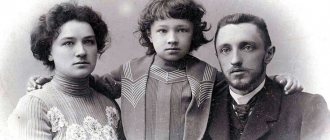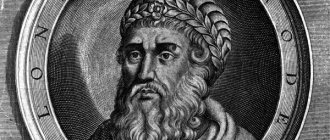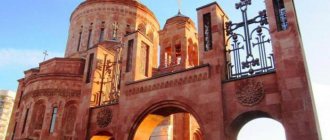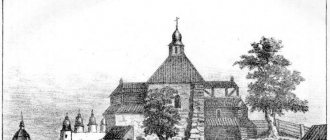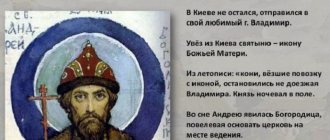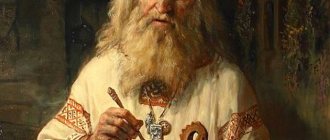Venerable Euphrosyne of Polotsk is the mother of female monasticism in Rus', the first abbess of a monastery for women, an example of asceticism and spiritual purity, a mentor of Russian women, called by God to care for them both in the past, present and future.
Having given birth in the lands of present-day Belarus, died in Jerusalem, and was buried in the Pskov lands, this fragile woman became a symbol of the unification of Russian lands and Christians around the world. On May 23, the Orthodox world pays tribute to the memory of St. Euphrosyne, who still brings joy to the world.
Features of life in Polotsk before the advent of the Mongols
This story should begin with a brief description of the life of the inhabitants of Ancient Rus' in order to understand at what time Euphrosyne of Polotsk, one of the most educated women of her time, was born.
The 12th century was the period when the inhabitants of ancient Rus' began to actively accept the Orthodox faith. The new faith began to be reflected in architecture, literature and art.
Orthodox churches were decorated with scenes from the Bible; scriptoriums were opened at many monasteries, where translators from Greek and copyists of books worked; Jewelry workshops have become relevant.
Polotsk itself at that time was one of the largest centers for the production of books, as well as an excellent place for those wishing to receive an education. Chronicles were written here, from which we can now glean knowledge about outstanding personalities of that time.
Iconography
The iconography of St. Euphrosyne actively developed in modern times on the territory of Russia, Belarus and Ukraine. The appearance of the saint is also mentioned in many texts from the sacred books of those times. The oldest image for a long period was considered to be a fresco placed on a column in the Spassky Church of the Polotsk Nunnery.
On many icons, Euphrosyne is depicted next to a table on which a cross, rosary and books are laid. With her left hand the saint holds another cross, and with her right hand she points to the princely accessories. A characteristic feature of the image is the nun’s upward gaze. An icon is also common, where the Venerable Euphrosyne is dressed in monastic clothes with a pectoral cross on a dark background and a slight radiance near her head.
The childhood and adolescence of Saint Euphrosyne
The exact date of birth of the Great Ascetic is unknown. Historians have established that Euphrosyne of Polotsk was born in the world of Predslava, approximately in 1101. The girl's pedigree was similar to that of the noble Rurik family. She was the granddaughter of Vladimir Monomakh himself, as well as the daughter of Prince George of Polotsk.
Predslava’s father took care of his daughter’s education from an early age; she was taught by monks. In the prince's house there was a very large library, where there were many books of both a religious and secular nature. The girl had a great interest in reading. The description of Euphrosyne of Polotsk and her life is taken from chronicles that were written by witnesses of that time.
Among her favorite books were the Holy Scriptures and the Psalter. In addition to reading, the girl prayed often and earnestly. Rumors about a girl wise beyond her years quickly spread far beyond the borders of the land of Polotsk, so many of the noble princes dreamed of such a wife.
Construction of the temple
In the middle of the 12th century, on the site of the wooden church, Euphrosyne of Polotsk decided to build a stone one. To fulfill her dream, she came to John for advice. This monk already had experience in building temples. According to “Life...” all the work went quite quickly. Already after 30 weeks, the temple of Euphrosyne of Polotsk was erected. Its opening took place in 1161. “Life...” tells about a miracle that happened at the very end of construction. It was that during the construction process the bricks ran out and the masons did not know how to complete their work. But the next day, after the saint’s prayer, the craftsmen discovered the required material in the furnace.
The Temple of Euphrosyne of Polotsk never ceases to amaze researchers. It differs from many buildings of that time in its proportions, gable roof, and unusual elongation of the drum. The interior of the church itself seems mysterious to visitors: despite the massive walls, it is loaded with thick pillars.
Deciding to become a nun
When Predslava was 12 years old, one of the princes took her in marriage. The parents gave their consent, but the girl made a completely different decision. Euphrosyne of Polotsk, whose biography from that moment received a new twist, secretly went to the monastery.
The abbess of this monastery was the widow of her uncle Roman. When the abbess heard a request for permission to take monastic vows, her first decision was to refuse. The girl was still too young and also very beautiful. Yet over time, seeing the passionate prayer, faith and intelligence of Predslava, the abbess gave her consent, not fearing the anger of the girl’s father.
So Euphrosyne became a nun.
Temple equipment
After the construction of the new church, Euphrosyne actively worked to ensure that this house of God had everything necessary for holding services. The nun invited artists who painted the walls with biblical scenes, which depicted the faces of saints. Drawings of amazing beauty were painted on the choir, as well as in the cell intended for the Reverend.
For her own monastery in the church, Euphrosyne acquired an icon of the Mother of God (the miraculous Hodegetria of Ephesus). According to legend, it was written by the Evangelist Luke himself.
tonsure
When she was tonsured, Predslava was given a different name, now she became Euphrosyne. The choice of this name was not accidental. Euphrosyne of Alexandria, who lived in the 5th century, was an excellent example for a girl. In addition, this name means “joy,” so there were several prerequisites for choosing this name.
Euphrosyne's parents were saddened by her decision and made attempts to bring their daughter home. According to the chronicle, Prince George cried for his daughter as if she were dead, but these tears did not change anything. Euphrosyne of Polotsk remained in the monastery, where she surpassed everyone in her zeal for prayer, fasting and night vigils.
Having become a nun, the girl devoted herself to various sciences. She studied the books that she found in church repositories, and these were the works of Slavic theologians, ancient chronicles, as well as the works of Byzantine and Roman enlighteners.
What do they ask for before the image?
By praying before the image of the abbess, believers ask for salvation, deliverance from addictions, protection of loved ones, and a peaceful existence. The text of the church prayer contains an appeal and praise to the holy princess Euphrosyne. Before the image they read not only a prayer, but also a kontakion and a troparion.
Blessings Saint
Saint Euphrosyne learned about her destiny from a dream. The Angel himself, who appeared in a dream, ordered her to found a new monastery near Polotsk, in an area called Seltso. Having seen such an omen several times, Euphrosyne learned that Bishop Elijah of Polotsk had also seen the same dream. These signs of God led Bishop Elijah to give her the Church of the Transfiguration so that a convent could be founded there.
Euphrosyne of Polotsk can be described as a woman who became famous for the founding and guardianship of monasteries. Indeed, in addition to the convent, she was the trustee and founder of the Bogorodsky men's monastery.
The saint opened schools at the monasteries, where novices were taught various crafts, literacy, and the art of copying books.
Euphrosyne became famous as an adviser; she never refused advice to those who needed guidance on the path to faith. The power of her prayer was so great that those who wanted to change and live a godly life often turned to her for help. Many who came to her received spiritual support and help. She was able to calm down the quarrels and showdowns that at that time often occurred between the princes.
Prayers
Troparion, tone 4
Imitating the twelve-year-old Christ, / who taught the word of God in the sanctuary, / you followed, Euphrosyne. / Leaving the temporal glory and the earthly betrothed, / and despising all the worldly, / you disgraced the most beautiful Christ of all, / taking up the cross, walking the path of the angelic life / and Instructing many to Him, / in the fragrance of peace, you ascended into the Heavenly Palace, / where you prayed, You loved Him, / for those who reverently honor your memory.
Troparion, tone 4
Having squandered your wealth on the beggars/ and counted your princely glory for nothing,/ you, the red maiden, abhorred the temporary betrothed/ and, disgraced by the Bridegroom Christ,/ to him, like a vein, you brought purity of soul and body, Euphrosyne./ To him now he is in joy. as you stand, / remember us who honor your memory.
Kontakion, tone 8
Chosen by God from birth/ and recognized to serve Him,/ in the rank of angels of the Lord, who served holyly,/ and lived reverently,/ and now, with the Heavenly powers, praising the Lord,/ for us, sinners, interceding before the Lord,/ with joy and love Let us cry:/ Rejoice, Euphrosyne, all-honorable bride of Christ.
Kontakion, tone 8
Our pure virginity and honor/ with alms, like a lamp with oil, who adorned/ and with the wise virgins entered into the bright chamber of Christ,/ let us please the glorious Euphrosyne/ and, falling to the honest with her power, we will enjoy her fragrance/ and cry out to her tenderly:/ as having boldness towards Christ God / pray to be delivered from the stench of passions and to save our souls.
Euphrosyne's dream
The Venerable Euphrosyne had her own cherished dream - she really wanted to visit the holy places of Palestine. She decided to fulfill this desire, being far in old age.
Previously, the life of Euphrosyne of Polotsk was devoted to rewriting and writing her own books and teachings for the laity, as well as organizing the life of monks at monasteries. Having achieved what was planned, she, leaving the monastery to her sister Evdokia, went on a journey.
On the way to Jerusalem, she met with Patriarch Luke of Constantinople. And having arrived at her destination and visited the Life-Giving Sepulcher of the Lord, she stopped at the Russian Monastery.
It was here that illness overtook her. On May 23, 1173, without being cured, Euphrosyne passed away. According to the saint's will, her body was buried in the monastery of St. Theodosius, not far from Jerusalem.
Since 1187, her relics were kept in the Kiev Pechersk Lavra, and in 1910 they were returned to Euphrosyne’s homeland in Polotsk, where they are still located.
Where can you find relics
In 1187, Muslims captured the territory of Jerusalem, and the sacred relics were sent for burial in the Theodosian Cave. On the urgent orders of Emperor Nicholas II, at the beginning of the 20th century, the relics were transported to Euphrosyne’s homeland and placed in the Spaso-Euphrosyne Monastery. To store the incorruptible remains, a special cypress shrine with silver trim was prepared. Many religious people made donations for the creation of the raki.
The cancer with the remains was once again transported in 1915, when evacuation took place due to military operations. Then the holy relics were placed in the Rostov Avraamiev Monastery. In modern times, the remains are located in the Holy Cross Church.
Euphrosyne of Polotsk: interesting facts
The saint was a famous philanthropist. She made her efforts to ensure that the Polotsk chronicle was not stopped; took care of the constant replenishment of the library of the St. Sophia Cathedral with new books.
One of the main attractions associated with her name is the cross of Euphrosyne of Polotsk. This masterpiece of ancient Russian culture was created by her order and named after her.
The cross had miraculous powers; it was used only in especially solemn services. There is a legend that Ivan the Terrible took the cross of Euphrosyne of Polotsk with him on his campaign against Polotsk. He promised that if he won, he would return the relic to its place, and, despite the enormous value of the cross, he kept his word.
Unfortunately, the relic was lost during the Great Patriotic War, but in 1997, according to surviving descriptions, a copy of the cross was made by Brest jewelers.
Euphrosyne was canonized in 1547, and in 1984 she was included in the Council of Belarusian Saints. Since 1994, the day of the saint’s death has become Saint Euphrosyne’s Day and is widely celebrated in Belarus.
Life
Life of St. Euphrosyne of Polotsk has been preserved in a large number (at least 130) of copies of the 16th-17th centuries as part of collections and Menaions of four, the lists are divided into several. editions [21]. Researchers (Archbishop Filaret (Gumilevsky), V. O. Klyuchevsky, E. E. Golubinsky, A. I. Sobolevsky) are unanimous in the opinion that the original text of the Life, replete with numerous historical realities, was created in pre-Mongol times, but in extant The lists present a variant that was strongly influenced by the style of “weaving words”, which became famous in Russian literature no earlier than the turn of the 14th century. The earliest list of the lengthy edition of the Life was found by B. M. Kloss [10] and dates back to the beginning of the 16th century. This manuscript, which also contains the service of the saint, comes from Western Russian lands and was not created in Polotsk. We can speak with confidence about the editing of the Life in the 1530s during the compilation of the Great Menaion of Mena in Novgorod (this version is presented in all later lists of the Menaion of the Four) and when the Life was included in the 1560s in the “State Book of the Royal Genealogy.” In 1700, a new edition of the lengthy Life of the Saint, based on the version of the Great Menaions, was published as part of the “Book of Lives of Saints” by St. Demetrius of Rostov [22]. Extensive editions of the Life were created in the 19th century.
In a limited number of lists from the 16th century, the prologue Life of St. Euphrosyne, probably created in the second half of the century. in the Western Russian Metropolis. The oldest copy of the short Life of the saint was discovered by Kloss in the Prologue of the last quarter of the century [23]. Two other lists of this edition are included in the Prologues from the former. collections of the Vilna Public Library [24], they are based (judging by the presence in both lists of the Life of St. Ignatius, Bishop of Rostov) probably based on a manuscript of Rostov origin. A new prologue Life, different from that found in earlier manuscripts, was compiled for the 1662 edition based on the text in the Degree Book [25]. Stories of the Life of St. Euphrosyne in the Great Russian manuscript and early printed tradition (except for its inclusion in the Great Menaion-Chetya) has a certain political connotation. It is likely that the creation of a new edition of the lengthy Life for the Degree Book is associated with the capture of Polotsk by Russian troops in 1563, and the appearance of the prologue edition in 1662 with the surrender of Polotsk in 1654 and the subsequent inclusion of the term “ White Rus'".
What else is known
It is impossible to describe all the interesting moments from the life of such a multifaceted personality. Let's list some:
- The saint is considered the patroness and intercessor of Belarus.
- She loved and composed music herself.
- She patronized artists and is considered the first philanthropist in Belarus.
- She took part in the political life of the state.
- In politics I tried to play the role of a peacemaker.
- Euphrosyne is recognized as a saint not only by Orthodox Christians, but also by Catholics.
- In 2007, a commemorative silver coin was issued in Belarus.
- Temples in honor of the saint are located not only in Belarus and Russia, but also in America and Canada.
Love of books
Euphrosyne (then Predslava) received a good education, knew foreign languages, and loved to read since childhood. When she became a nun, she settled in a cell near the St. Sophia Cathedral, where she began copying books.
Copying books at that time was hard work, which only men . Titles in books had to be decorated with artistic designs. I could write no more than 4 pages per day. “The hand on the book turns dull white,” wrote the Polotsk poet Naum Galperovich.
Monastery
Euphrosyne of Polotsk is considered the founder of not only the women's monastery. By her order, a monastery was built, and with it - the Church of St. Mother of God.
Subsequently, both monasteries became real centers of education for the Principality of Polotsk. In the schools they opened, young people learned writing and literacy. There were libraries and book writing workshops here, as well as icon painting and jewelry work. The Venerable Euphrosyne of Polotsk herself created and then recorded prayers and sermons. But in addition to her educational activities, the nun was known to her contemporaries as an adviser, peacemaker and fair judge.
Altar Cross
A special place in the new temple was given to the item made by the best jeweler of Kievan Rus, Lazar Bogsha. This is the cross of Euphrosyne of Polotsk. It was ordered by a nun specifically for the church she built. The exact date of manufacture (1161) and the name of the master were visible on the cross.
The cross of Euphrosyne of Polotsk has a six-pointed shape. According to theologians, such a decision is a symbol of primeval light. The six ends of the cross mean the six days during which the Lord created the world. The masterpiece of ancient jewelry was decorated with illustrations relating to the entire history of the New Testament, as well as the ancient church. The cross (see photo) of Euphrosyne of Polotsk had images of Christ and the Mother of God, Archangel Gabriel and Michael, the apostles Paul and Peter, Saint Euphrosyne herself, as well as John the Baptist. This historically significant item was decorated with precious metals and stones.
But the particles of holy relics gave the relics special value. Thus, in the upper crosshair on the front side of the Cross the Blood of Christ was placed. A little lower is the “Life-Giving Tree.” In the upper crosshair on the reverse side there was a stone taken from the Sepulcher of the Most Holy Theotokos, and below was a particle of the Holy Sepulcher.
Unfortunately, during the war with Nazi Germany, the shrine disappeared without a trace. This Cross, like the notorious Amber Room, is considered one of the most valuable works of art, the search for which continues to this day. Today, in the St. Euphrosyne Monastery of Polotsk there is an exact copy of the relic, which was made in 1997 by the Brest jeweler-enamel maker N.P. Kuzmich.

